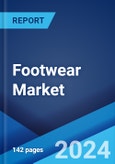Increasing Fashion Consciousness Among Individuals Impelling Market Growth
The footwear market has been experiencing continuous growth on account of the shifting preferences of consumers toward footwear that matches their daily outfits, along with the increasing number of individuals wearing different footwear for different occasions. Vendors are also expanding their catalogue to meet the demand of people. In addition, there is a rise in demand for fashionable footwear that helps in reflecting the individuality of a consumer. There is also an increase in the demand for trendy footwear among women, especially with beads, frills, lace and other intricate work. Moreover, the easy availability of footwear and rising fashion consciousness among people of all age groups contribute considerably in replacement purchases.Competitive analysis such as market structure, market share by key players, player positioning, top winning strategies, competitive dashboard, and company evaluation quadrant has been covered in the report. Also, detailed profiles of all major companies have been provided. The market structure is fragmented with the presence of a few large players operating in the industry due to low product differentiation. The volume of new entrants is also low in the footwear industry due to the presence of a large number of players, minimum capital investments, and easy access to distribution networks.
- What is Footwear?
COVID-19 Impact:
The COVID-19 pandemic outbreak resulted in a severe problem for the footwear industry and imposed unprecedented challenges on numerous countries. It also created a serious disturbance in the packaging sector and hampered the supply chains, which resulted in shortages and increments in the price of raw materials. This also caused a significant drop in the production of footwear and order delays for the packaging companies. Moreover, the shutting down of retail outlets led to a decline in the demand for footwear.Footwear Market Trends
At present, key market players are extensively investing in marketing strategies, such as celebrity endorsements, social media promotion, and banner advertising, which represent one of the key factors positively influencing the market. In addition, changing consumer preferences and increasing adoption of new technologies are offering lucrative growth opportunities for key market players to introduce innovative designs and features that offer more comfort. Moreover, the rising penetration of high-speed internet and the increasing usage of e-commerce websites through which companies are providing fast and convenient functional experiences to customers, such as secured payment gateways, grievance management, after-sales services, and competitive pricing, is strengthening the market growth. Apart from this, small and local vendors are finding success in reaching premium customers by making their products available online and thus available on a national scale. Additionally, the escalating demand for healthy footwear with orthopedic recommendations that aid in ankle problems and inflammation in the foot is fueling the market.Key Market Segmentation:
The report provides an analysis of the key trends in each sub-segment of the global footwear market report, along with forecasts at the global and regional level from 2023-2032. The report has categorized the market based on product, material, distribution channel, pricing and end-user.Product Insights:
- Non-Athletic Footwear
- Athletic Footwear
Material Insights:
- Rubber
- Leather
- Plastic
- Fabric
- Others
Distribution Channel Insights:
- Footwear Specialists
- Supermarkets and Hypermarkets
- Departmental Stores
- Clothing Stores
- Online Sales
- Others
Pricing Insights:
- Premium
- Mass
End User Insights:
- Men
- Women
- Kids
Regional Insights:
- North America
- Europe
- Asia-Pacific
- Middle East and Africa
- Latin America
Competitive Landscape
The report has also provided a comprehensive analysis of the competitive landscape in the global footwear market. Some of the companies covered in the report include:- Nike Incorporation
- Adidas AG
- PUMA
- Geox S.p.A
- Skechers USA, Incorporation
- Timberland
- Crocs Retail, Inc.
- Ecco Sko A/S
- Wolverine World Wide, Inc.
- Under Armour Inc.
Key Questions Answered in This Report
1. What was the size of the global footwear market in 2023?2. What is the expected growth rate of the global footwear market during 2024-2032?
3. What are the key factors driving the global footwear market?
4. What has been the impact of COVID-19 on the global footwear market?
5. What is the breakup of the global footwear market based on the product?
6. What is the breakup of the global footwear market based on the material?
7. What is the breakup of the global footwear market based on the distribution channel?
8. What is the breakup of the global footwear market based on the pricing?
9. What is the breakup of the global footwear market based on the end-user?
10. What are the key regions in the global footwear market?
11. Who are the key players/companies in the global footwear market?
Table of Contents
Companies Mentioned
- Nike Incorporation
- Adidas AG
- PUMA
- Geox S.p.A
- Skechers USA Incorporation
- Timberland
- Crocs Retail Inc.
- Ecco Sko A/S
- Wolverine World Wide Inc. and Under Armour Inc.
Methodology

LOADING...
Table Information
| Report Attribute | Details |
|---|---|
| No. of Pages | 142 |
| Published | January 2024 |
| Forecast Period | 2023 - 2032 |
| Estimated Market Value ( USD | $ 243.6 Billion |
| Forecasted Market Value ( USD | $ 332.3 Billion |
| Compound Annual Growth Rate | 3.5% |
| Regions Covered | Global |
| No. of Companies Mentioned | 9 |









